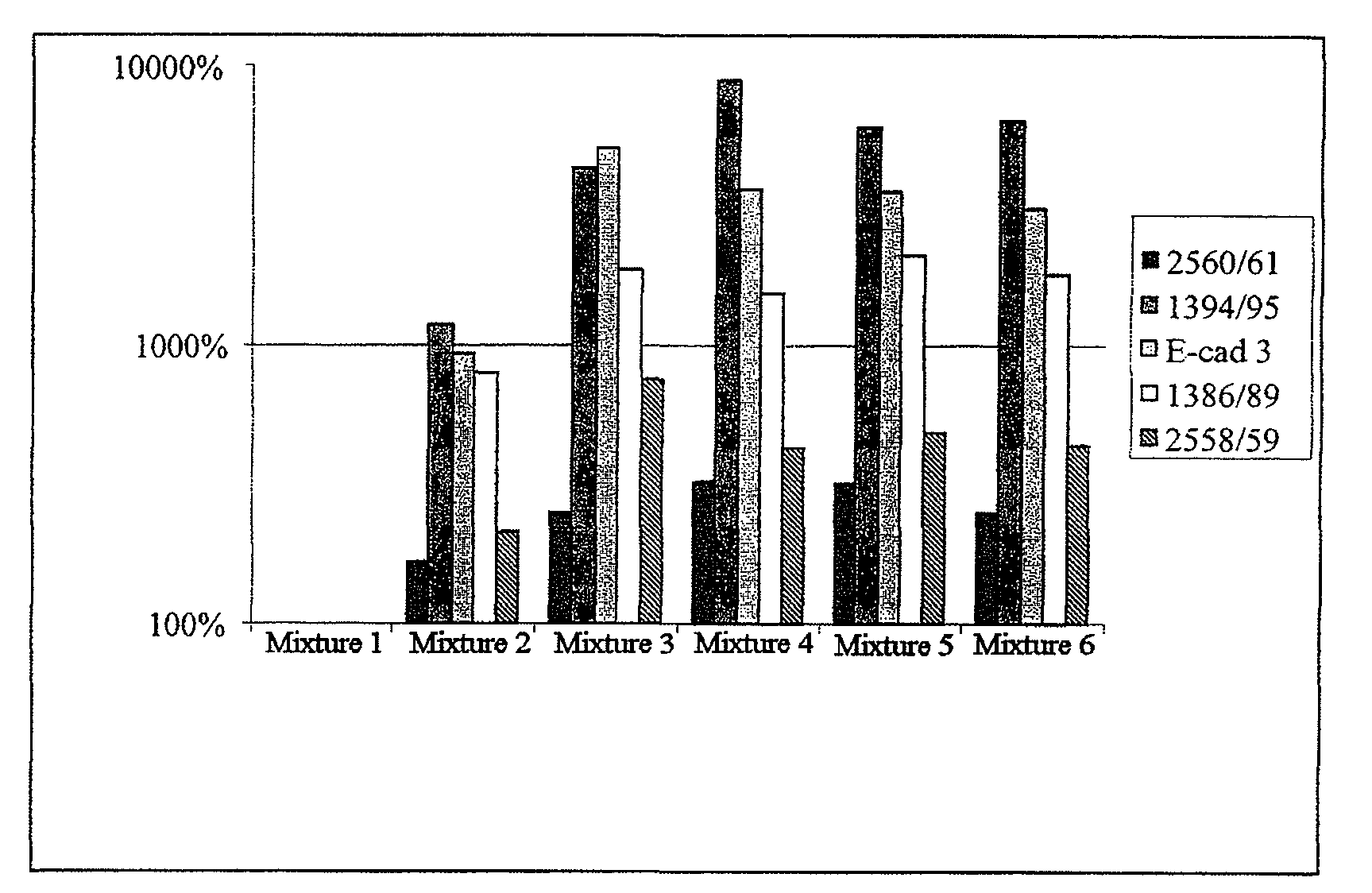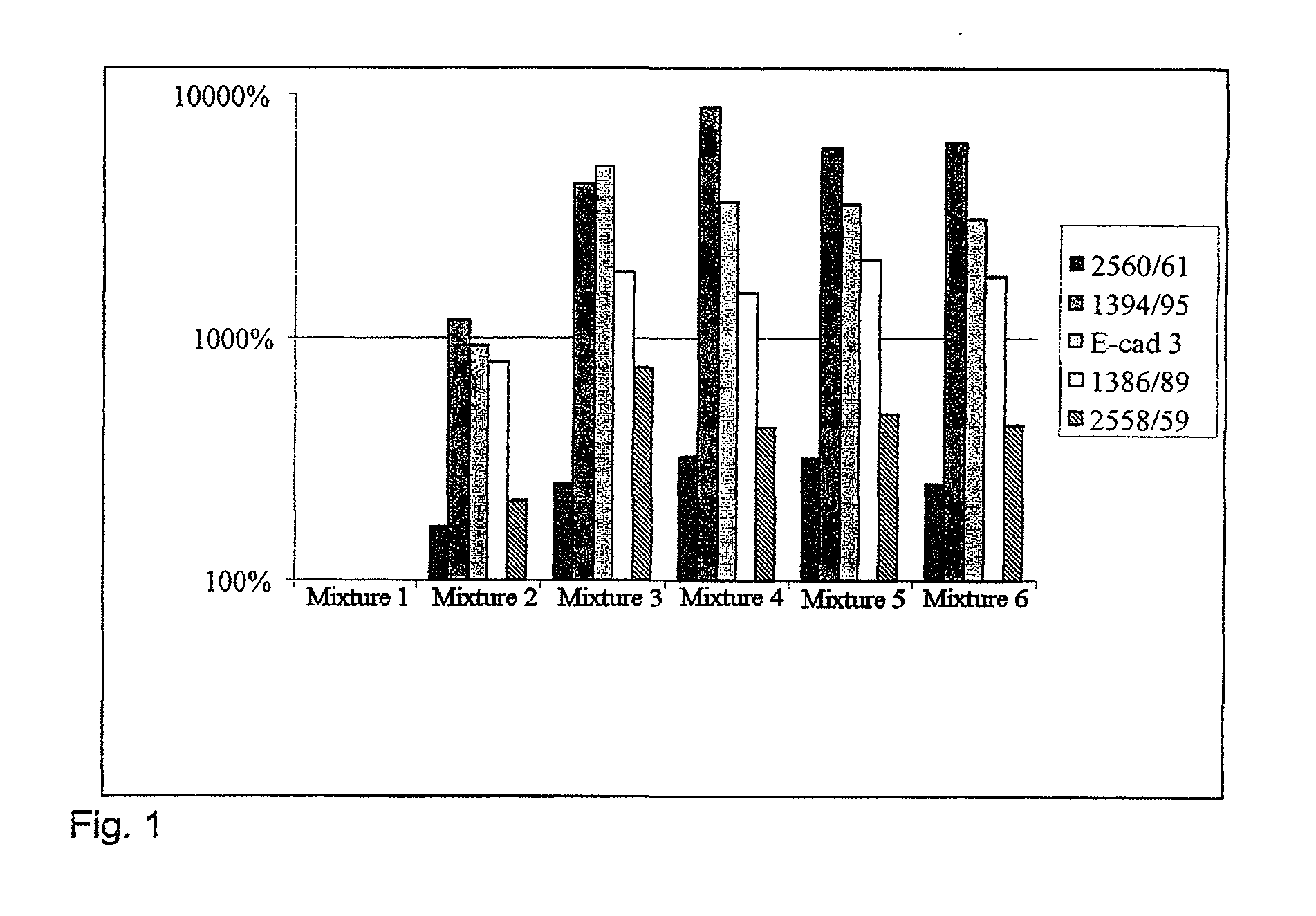Amplification of bisulfite-reacted nucleic acids
a technology of nucleic acids and bisulfite, applied in the field of molecular biology and epigenetics, can solve problems such as great difficulties, and achieve the effect of amplification of nucleic acids subjected to conversion
- Summary
- Abstract
- Description
- Claims
- Application Information
AI Technical Summary
Benefits of technology
Problems solved by technology
Method used
Image
Examples
example 1
[0085]Genomic DNA was obtained from human blood with the aid of the QIAamp method (QIAGEN) according to a standard protocol. 1 μm of the DNA obtained in this way was used for a bisulfition reaction (conversion reaction) using the EpiTect Kit (QIAGEN) according to a standard protocol. 5 μl of the purified converted DNA were used for a whole genome amplification. To this end, the REPLI-g Kit (QIAGEN) was employed, with 29 μl of the REPLI-g Midi reaction buffer, 2 μl of the REPLI-g Midi polymerase (Phi29 polymerase) and different volumes of a mix of 10 mM dATP and dTTP being added to 5 μl of the purified converted DNA. The initial concentration of dGTP and dCTP was constantly fixed to 1 mM.
TABLE 1Volumes of the dATP / dTTP mix which were added to the REPLI-greactions and the initial concentrations resulting therefrom inthe mixturedATPdTTPdGTPdCTPMixture 10 μl 1 mM 1 mM1 mM1 mMdATP / dTTPMixture 21 μl1.24 mM1.24 mM1 mM1 mMdATP / dTTPMixture 32 μl1.48 mM1.48 mM1 mM1 mMdATP / dTTPMixture 43 μl1...
example 2
[0091]Genomic DNA was obtained from human blood with the aid of the QIAamp method (QIAGEN) according to a standard protocol. 1 μg of the DNA obtained in this way was used for a bisulfition reaction (conversion reaction) using the EpiTect Kit (QIAGEN) according to a standard protocol. 5 μl of the purified converted DNA were used for a whole genome amplification. To this end, the REPLI-g Kit (QIAGEN) was employed, with 29 μl of the REPLI-g Midi reaction buffer, 1 μl of the REPLI-g Midi polymerase (Phi29 polymerase) and different volumes of a mix of 5 mM dATP and dTTP being added to 5 μl of the purified converted DNA. The initial concentration of dGTP and dCTP was constantly fixed to 0.24 mM.
TABLE 3Volumes of the dATP / dTTP mix which were added to the REPLI-greactions and the initial concentrations resulting therefrom inthe mixturedATPdTTPdGTPdCTPMixture 10 μl0.24 mM0.24 mM0.24 mM0.24 mMdATP / dTTPMixture 25 μl0.83 mM0.83 mM0.24 mM0.24 mMdATP / dTTPMixture 36 μl0.95 mM0.95 mM0.24 mM0.24 mMd...
PUM
| Property | Measurement | Unit |
|---|---|---|
| Fraction | aaaaa | aaaaa |
| Fraction | aaaaa | aaaaa |
| Fraction | aaaaa | aaaaa |
Abstract
Description
Claims
Application Information
 Login to View More
Login to View More - R&D
- Intellectual Property
- Life Sciences
- Materials
- Tech Scout
- Unparalleled Data Quality
- Higher Quality Content
- 60% Fewer Hallucinations
Browse by: Latest US Patents, China's latest patents, Technical Efficacy Thesaurus, Application Domain, Technology Topic, Popular Technical Reports.
© 2025 PatSnap. All rights reserved.Legal|Privacy policy|Modern Slavery Act Transparency Statement|Sitemap|About US| Contact US: help@patsnap.com


